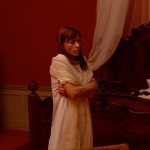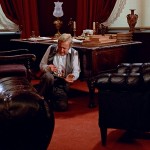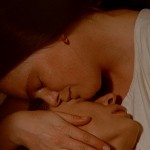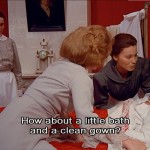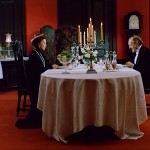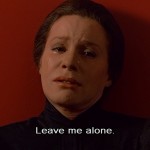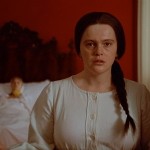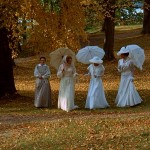
Cries and Whispers – 1973
I have no idea what I just watched. I’m not sure I fully understood it. It was like a film that was trying too hard to be deep and artsy. It isn’t that what actually happened in the plot was hard to follow. It’s just that the characters were strange, their motivations were confusing, and the directing style that was used was, for lack of a better word, creepy.
This was a foreign film directed by Ingmar Bergman, and as such, was in Swedish with English subtitles. The plot was a bit eerie, delving into the psyches of four women. Harriet Andersson played the part of Agnes, a young woman dying of cancer. She is in constant pain and endures terrible suffering. Her two sisters, Maria and Karin, played by Liv Ullmann and Ingrid Thulan, are watching over her death bed, waiting for her inevitable demise. The fourth woman is the maid/nurse, Anna, played by Kari Sylwan. Hers was, at times, the strangest character of them all, but I’ll get to that in a bit.
In order to give a clear idea of how the characters were portrayed and developed, it is important to spend a moment talking about the choices Bergman made as a director. First, I’ll mention the use of the color red. The color permeated almost every aspect of the film. Everything from the sets to the costumes seemed to be saturated with the color with healthy smatterings of white and black. It gave the film a very striking look, bringing up images of passion and blood, while at the same time giving everything a feeling of sterility and detachment.
The music was sparse, furthering the surrealistic mood. The pacing was slow though I wouldn’t say plodding. While Agnes lay dying, each of the other three women are given their little moments of flashback, revealing how her death was affecting them, or at least how they were emotionally dealing with it. Each time these flashback sequences began, the camera would show a close-up on a woman’s face and the image would turn blood red before fading to black. Then when the memory would end, the black screen would become a red image of the woman’s face, which would then return to normal color. It gave everything an intensely ominous feel.
The use of silence was also a very prominent feature of the film. The first 6 or 7 minutes of the film has almost no sound at all: no dialogue, no music, and very few sound effects other than a ticking clock. It was all very mysterious and uncomfortable. Why use dialogue as a way of displaying emotion when long, silent, drawn-out shots of distressed facial expressions will do it better?
During these flashback segments, a few other characters are introduced. During Maria’s story, we meet two men: her husband Joakim, played by Henning Moritzen, and her lover, the doctor, David, played by Erland Josephson. David spends several minutes studying Maria’s face, explaining why she is more beautiful than ever, and yet less desirable. Joakim, when he begins to suspect his wife’s infidelity, attempts suicide. While he is bleeding, he begs Maria to help and she callously refuses, showing how shallow and calculating she is.
During Karin’s story, we meet the husband Fredrik, whom she despises, played by Georg Arlin. He is focused on his career and turns a blind eye to his wife’s unhappiness. But Karin is apparently dead inside, and the only way she can feel anything at all is to cut her vagina with a piece of broken glass. Then she goes to bed, bleeds all over the sheets and wipes the blood across her mouth. I’m not sure what this was supposed to mean.
And then there is Anna. She has been the family’s maid for many years, and the way she chooses to comfort the dying Agnes is to kiss her intimately, then remove her own clothes and press the sick woman’s face to her breast. This was very confusing. She is never shown to have been Agnes’s lover, so why would she do this? But it is all done with such gentleness and tenderness that there had to have been some kind of special connection somewhere.
Anna’s special scene, which took place after Agnes’s death, wasn’t a flashback, but a strange sequence in which each of the three women are called, in turn, by the ghost of Agnes who is begging for comfort. Karin, who cannot feel emotion, rejects the shade, claiming that she does not care that she is dead. Maria tries to embrace the spirit, but becomes overwhelmed with grief and fear. She runs from the room screaming. Only Anna is able to comfort her, undressing for her one last time.
At the time of its release, this movie was lauded as a “magnificent, moving, and very mysterious new film,” and maybe it was. Maybe I’m being shallow calling it unnecessarily slow, confusing, pretentious, and melodramatic. Still, there was real emotion in it, something that is not always easy to achieve. If you like artsy, depressing films, you’ll enjoy Cries and Whispers.
